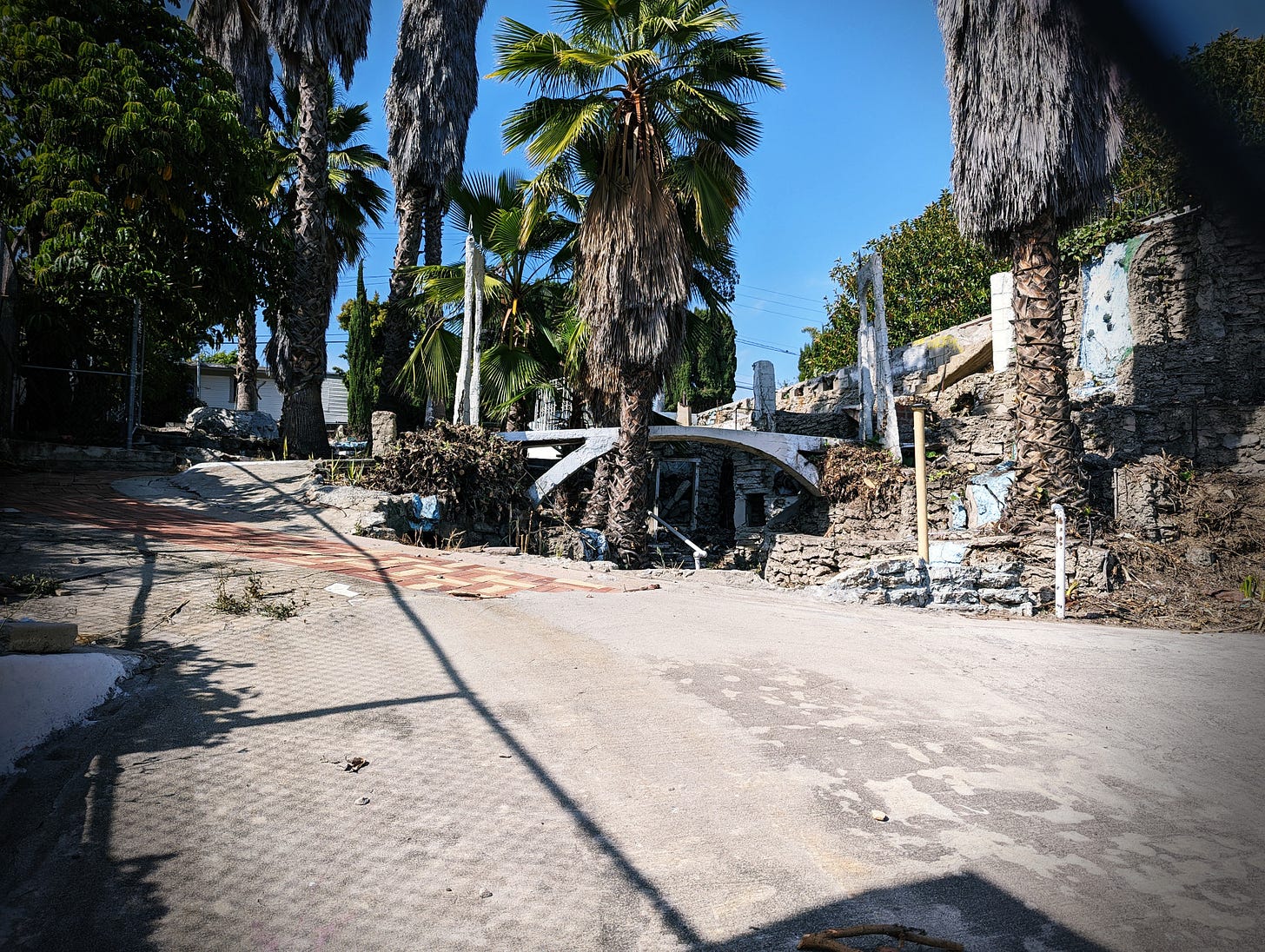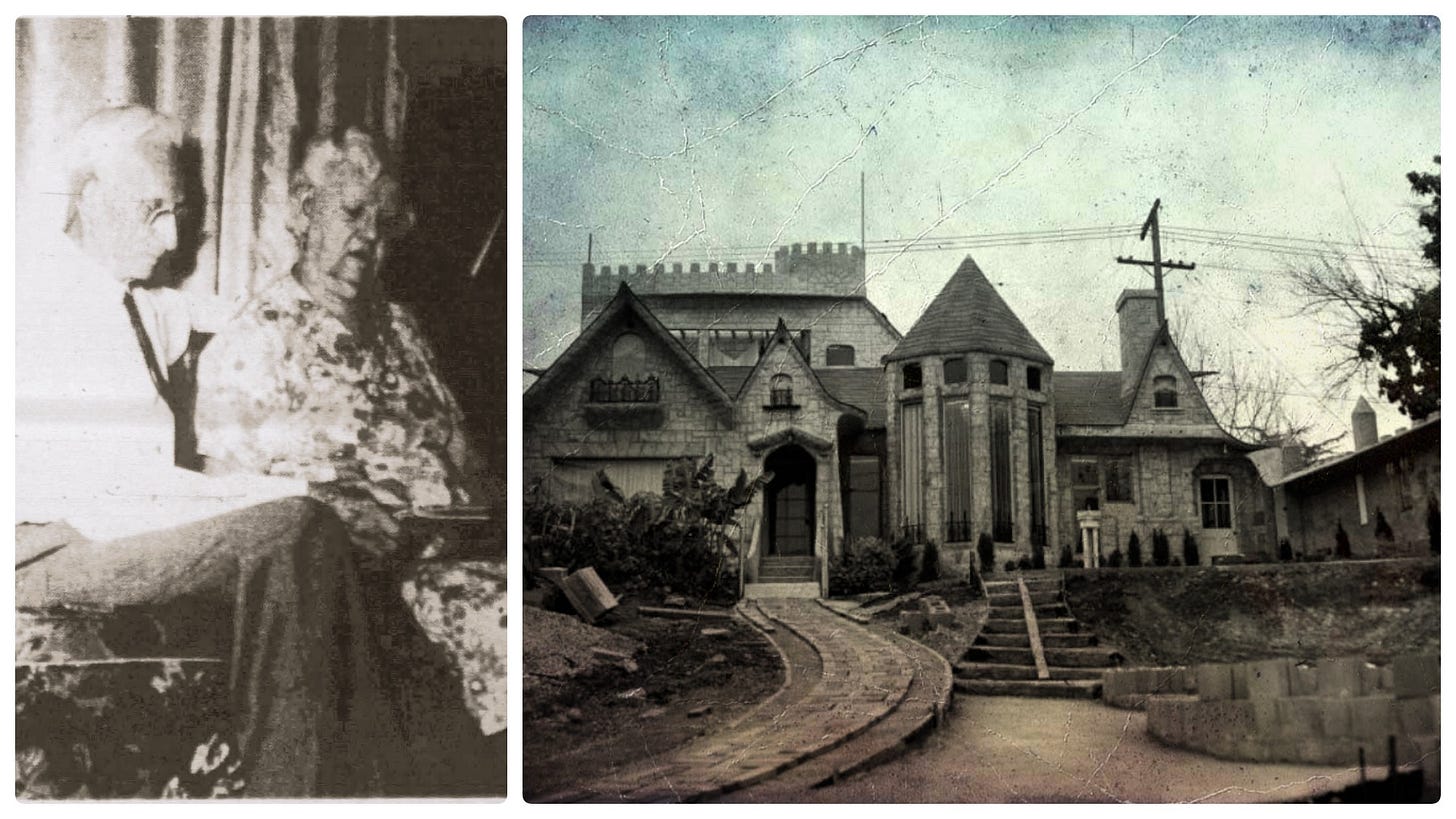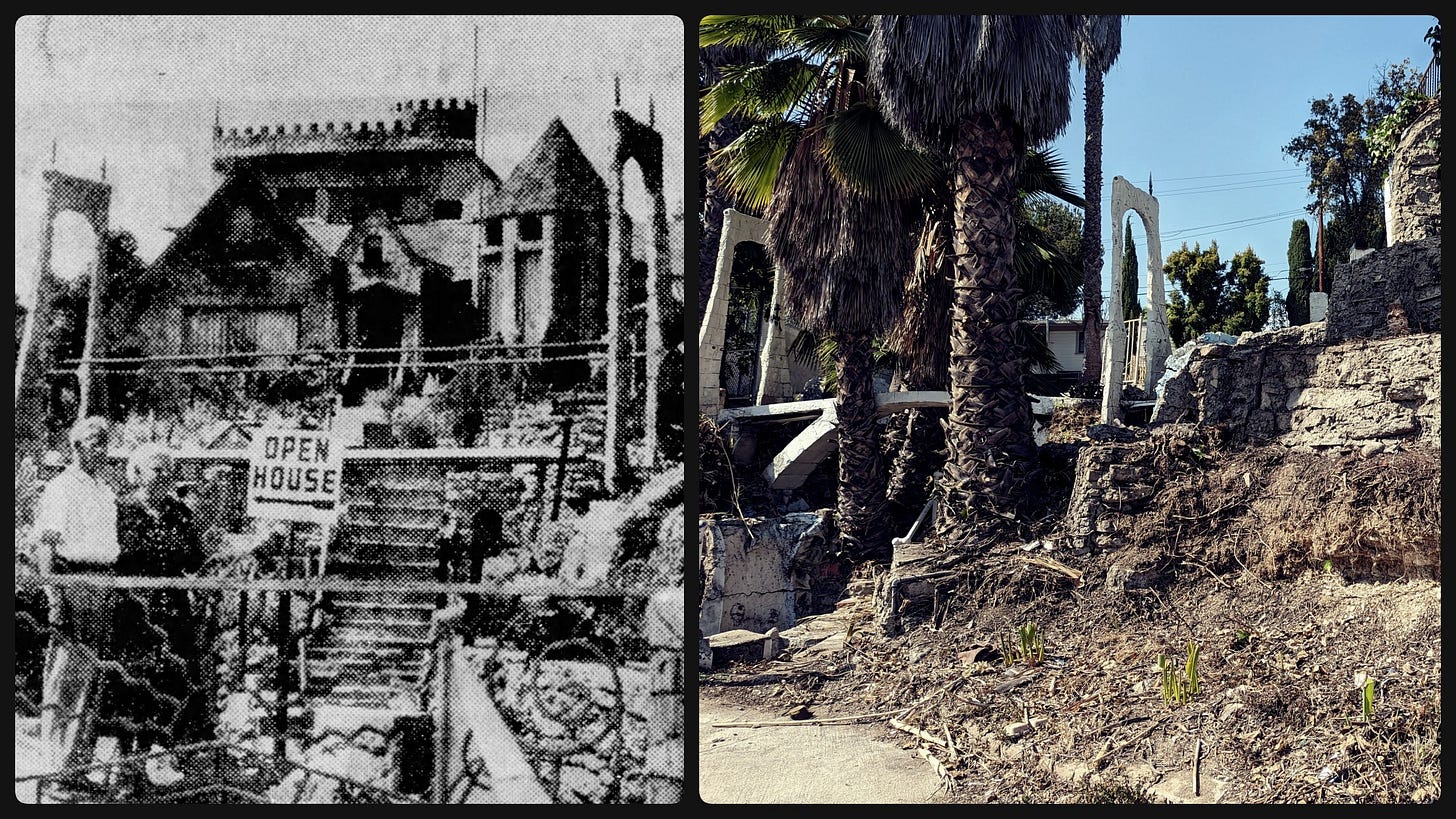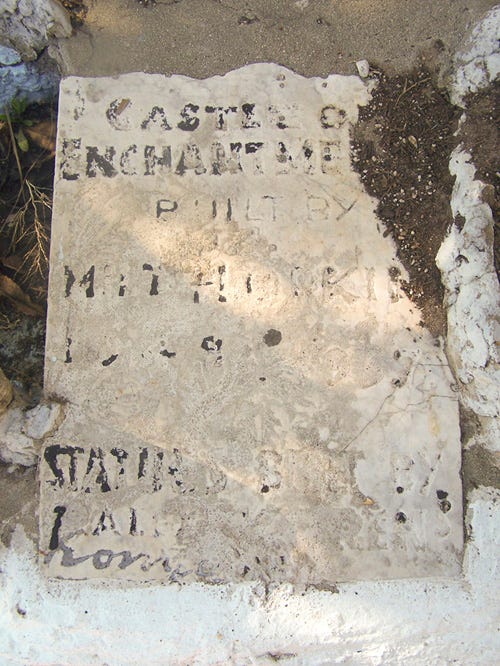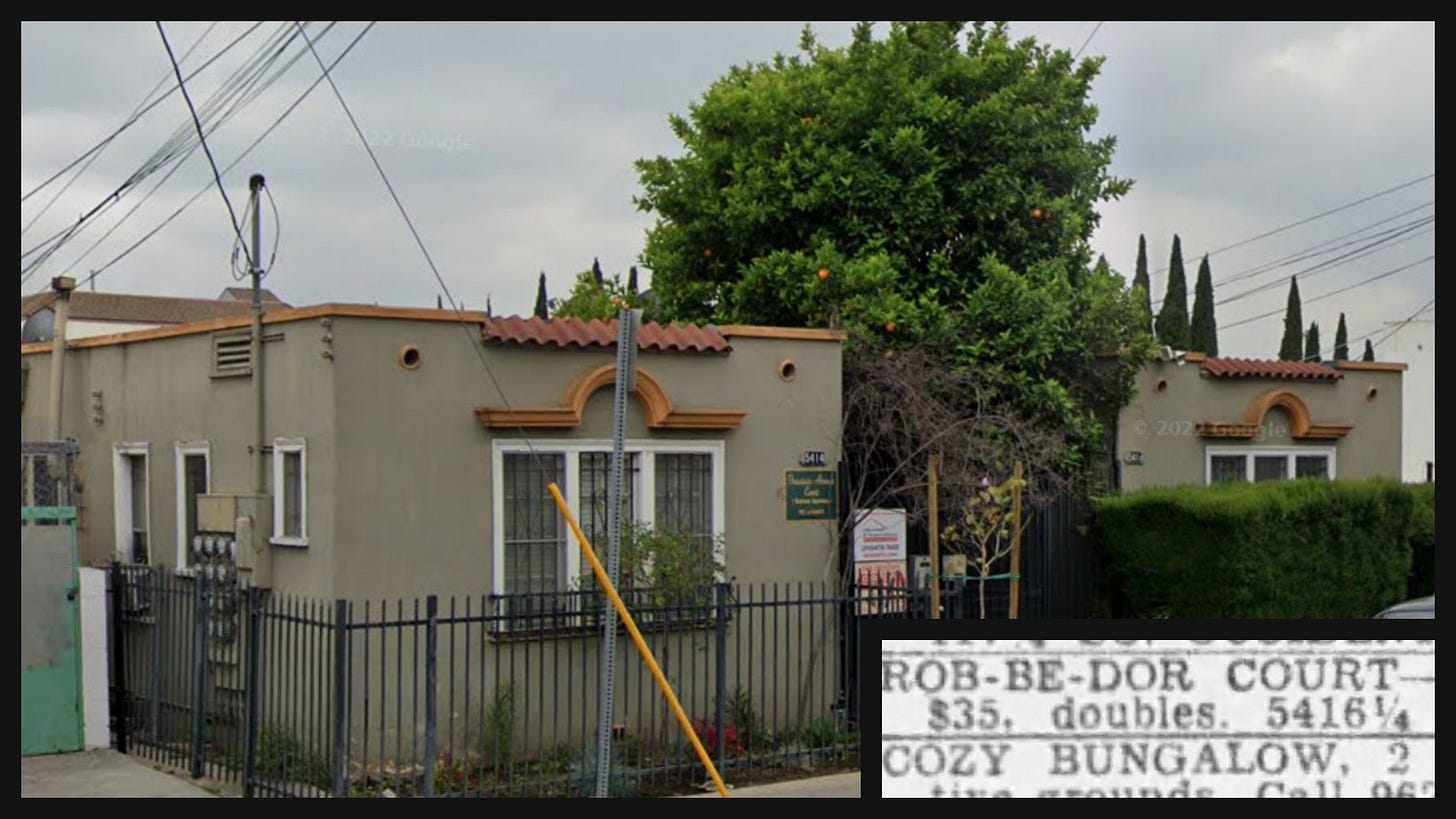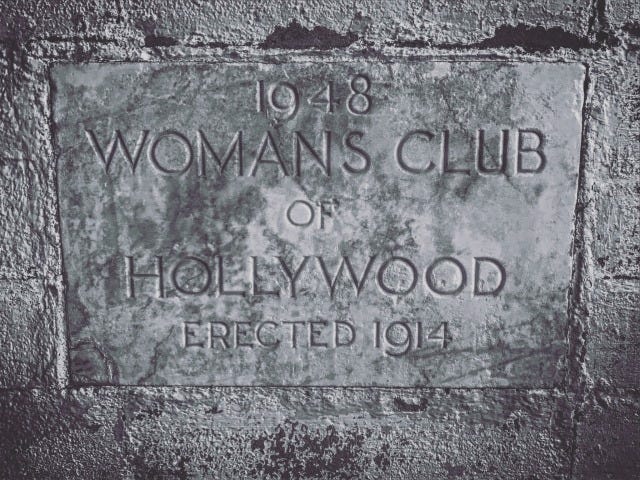Gentle reader,
Should you choose to study Los Angeles history, you’ll have to learn a lot about real estate, zoning, planning and the tricky ways money gets squeezed out of every square inch of El Pueblo de Nuestra Señora la Reina de los Ángeles. It’s been this way since the first speculators sold off swampy, subdivided lots to rubes fresh off the train from Iowa.
The video that accompanies this post is drone footage that Steve Lucero / The Artery shot at our request, documenting two separate Los Angeles parcels, three miles apart, that have recently been united in a most peculiar development scheme that has us asking a lot of questions. Perhaps someone reading this newsletter has the answers.
To the north in Hollywood, stands The Cahuenga Apartments, a 24-unit Mediterranean Revival structure that was built in 1923, and got cut in two in 1929, losing a 39’ x 50’ slice of living area when Cahuenga Boulevard was widened for the Five-Finger Plan traffic management project, which promised to “convert Hollywood overnight into a city of metropolitan rank."
Following this partial demolition, The Cahuenga Apartments’ pretty facade was tacked back on, and if you didn’t check historic building permits or climb up into the rafters, you’d never know it.
Down in the suddenly trendy Melrose Hill district just east of Paramount Studios is 4857 Melrose Avenue, which is presently an intriguing mess of an inaccessible, gated hillside “improved” with an empty, heavily tagged swimming pool, untended palm trees, delicate spindle arches topping a whitewashed moon bridge and meandering folk art pathways.
Until a few years ago, this was the site of an extraordinary symbol of romantic love, Milton S. Hopkins’ Castle of Enchantment (aka the Dream Castle) built for his second wife, Josie.
Amateur architect Milt was in his early sixties, soon to retire as a clerk with the Los Angeles County Sheriff’s Department, when Josie admired a mansion in Sarasota, Florida, where they were shopping for seashells for a store they hoped to open. Without missing a beat, Milt promised to build her something even more beautiful when they got back to L.A.
She might have thought he was just being sweet, but Milt was dead serious.
The couple didn’t have much money, but he had drive and ingenuity. Los Angeles was getting a new freeway punching its way across Hollywood, which meant many good old buildings in its path were available cheap, as salvage.
These were heady times for architectural magpies named Milt. Like Milt Larsen a few years later with the Magic Castle, Milt Hopkins window shopped for pretty bits and pieces of doomed buildings, and brought them back to the hillside lot where he and Josie lived in a three-room 1919 cottage that grew and grew.
It took eight years to finish the castle and its grounds, with pools and moats and waterfalls and hundreds of night lights and bridges and plantings, and clever tricks of perspective framing the crenelated castle at the crest. The hilly gardens were buttressed with tons of broken Hollywood sidewalk.
With no commercial advertising, the unusual house nevertheless became a roadside attraction. Milt was proud of his work, and liked talking about how he’d done it all for his sweetheart Josie, but didn’t feel it was right to charge money if nice people wanted to visit. Soon, the lookie-loos were coming by chartered coach class bus. It couldn’t last.
In 1971, Josie told the Santa Clarita Signal "It was nice to get that much attention, but after a while it got to be too much for us. People would just walk in the house late at night or early in the morning; sometimes they wouldn't even knock. And we were getting busloads of sightseers all the time." Not exactly the peaceful retirement they had planned on.
Milt had only promised Josie that he would build her the most beautiful home she could imagine, not that they would live in it forever—certainly not once it became a pain in both of their necks.
So in 1957, shortly after Milt built a greenhouse for Josie’s flowers, the Hopkinses sold the house that love built and set out to explore America by travel trailer. Later, they settled in the Mulberry Mobile Home Park in Newhall, which Milt managed. If you asked, they’d take out their scrapbooks and fill you in on castle living, pro and con. Josie lived until 1975, Milt until 1978; they’re at Grand View, Glendale.
Back in Hollywood, the Castle of Enchantment lived on, as a private residence where you could drop your kids off to get baby sat in a fairy tower, later rented to Andy Warhol associate Michael Boosin, who hosted visiting artists and took the best color photo of the place (above).
Owner Harry Alexan added a commercial kitchen and changed the zoning in 1977. In the mid 1980s, Pashree and Thom Sripipatana operated the popular Siamese Castle restaurant—Thai food was still something of a novelty in Los Angeles—and by 1990, it was a French restaurant, La Bastille.
The last business operating on the site was the Korean-owned Ko Kung Club, aka 고궁 (Old Palace). When it closed, few noticed. The structure has been shuttered and derelict for more than a decade, with numerous code violations reported. In 2013, shortly after one time patron 3940dxer captured a set of sad photographs, the owners pulled a demolition permit, and the castle home at the top of the lot was torn down. Few noticed that, either.
But they never finished the job. The garden features, pools, steps and landscaping remained, suffering vandalism and decay, their condition hard to assess from street level. In March 2022, the double lot property sold for an inflated $2.8 Million.
Which brings us to today, and the weird marriage with 1830 North Cahuenga. In May, plans were filed for demolition of the Hollywood apartment building, and for erection of a new, massively out of scale 20-story mixed-use luxury tower. Look at how it dwarfs the 46-unit Chateau Alto Nido apartments at upper left.
In July, a completely new set of plans were filed, this time calling for the Hollywood apartment house to be moved rather than demolished, to the Castle of Enchantment site on Melrose.
House moving used to be common in Los Angeles. Landlords and homeowners recognized the value of a well-constructed building, so instead of sending tons of wood, tile and concrete to the dump, older buildings were loaded on flatbed trucks—or sometimes logs, for shorter trips—and slowly rolled to a new home.
Heritage Square on the Arroyo is a living history museum of fine Los Angeles buildings that were saved from the wrecking ball, though the two founding landmarks—The Castle and Salt Box from Bunker Hill—were tragically lost to arson.
In 2016, we used social media to pressure affordable housing developer ELACC to move rather than demolish the lovely Tudor Revival Peabody-Werden house in Boyle Heights, though to date no effort has been made to restore, reactivate or historically designate it.
House moving is best left to the professionals. On September 15, 2007, when Esotouric had been giving bus tours for four months, we were not far from 1830 Cahuenga on the northbound 101, leading an early version of The Birth of Noir. Suddenly cars around us were slamming on their brakes and veering into the fast lane. Our tour guests had a front row seat for the notorious Hollywood Freeway amateur house moving fail—and we didn’t even get stuck in traffic.
Despite boasts of data transparency, there is presently no way to search L.A.’s Building and Safety files except by street address. So finding houses that have been moved is a matter of luck or informed research. Bunker Hill historian Nathan Marsak recently got the thrill of his life when a home from that demolished neighborhood was rediscovered—in Angelino Heights!
We usually like it when historic properties can be moved to be saved. But the proposed cross-town move of the Cahuenga Apartments smells funny. For one thing, they’re not actually proposing to move the building, just parts of it.
Conforming to its angled parcel, 1830 Cahuenga is an unequal trapezoid with a diagonal edge to the east and a projecting entrance bay to the north. Ads we’ve seen for single units in the building are around 400 square feet. The new project has a flat back wall, with units as small as 210 square feet. Tiny dwellings are very profitable in 2023, but no tenant in 1920s Los Angeles would accept such microscopic quarters.
It’s unclear what portion of the existing structure, exactly, developer CGI proposes to move to Melrose, how much of the existing interior will be sacrificed to turn desirable pre-war apartments into post-millennial micro-units, and what will happen in the meantime to the residents of the 24 rent controlled apartments.
Which makes us wonder: Are there any residents? With so many illegally vacant RSO apartments in Hollywood, we wouldn’t be surprised to learn there were none. Unfortunately, Los Angeles has no rent registry, so it’s hard to know if 1830 is operating properly as 24 RSO units, how large they are and if there are unexplained vacancies that would make such a switcheroo easier to accomplish. If anyone reading this has knowledge of the building and its tenants, do tell.
More questions: why unveil two such radically different plans within weeks of each other? It’s expensive to move a building and the Melrose lot was pricey, too. Did developer CGI get some internal City Planning Department pressure because, despite the false claim on page 9 of the original application, 1830 Cahuenga is in fact a known historic resource, listed on page 77 of Metro Rail’s 1987 DEIR? And would that historic status be compromised by moving the building to a new location and making the units smaller?

Then there’s the matter of the proposed new location. The Castle of Enchantment site was rezoned nearly 50 years ago as a restaurant, and operated as such until the prior owners shut it down, demolished the castle and kitchen, let the property become blighted and sat on it until flipping the parcel for a big profit. Now that it’s been sold, is it in the best interest of the Melrose Hill community that this remain a restaurant? Nobody has heard from the neighbors, just from developer Gidi Cohen of CGI, who only answers to his investors.
There are good reasons to be skeptical of Gidi Cohen. As described in our 2016 newsletter, Hollywood Heartbreak, or We Had to Kill the Villa Carlotta to Save It, he used his political pull with former councilman Mitch O’Farrell to intimidate, surveille and evict most of the RSO tenants at Hollywood’s grand Villa Carlotta in a failed attempt to make one of L.A.’s best affordable, artist’s apartment colonies into a boutique hotel. The Franklin Village community less than a mile from 1830 Cahuenga has not forgotten.
And what about what’s left of The Castle of Enchantment? The castle is gone, yes, but it’s clear from Steve Lucero’s drone footage and peering in from the sidewalk that much of the folk art garden structures survive, and in surprisingly good condition.
Reminiscing to the Santa Clarita Signal in 1971, Milt Hopkins was confident that he'd built something that would last. After all, he’d used steel. "It'll be there for at least a hundred years."
We’re three quarters of the way to that anniversary, and we’ve got to save something. In a better timeline, The Castle of Enchantment would been landmarked as a unique Hollywood folk art environment, or fully documented for HABS and the historic salvaged features again salvaged for creative reuse.
Somewhere in the garden is the plaque that 3940dxer photographed in 2011, with Milt’s signature on it. Milt and Josie’s moon bridge, with its delicate arches, it still beautiful. We can’t let this go to the landfill, as if it was garbage.
For in this wretched lot, we see the real magic of Los Angeles: the creativity of a senior citizen madly in love with his bride, seeking out useful junk and giving it a new life, bringing joy to strangers, filling column inches around the world.
We think Los Angeles needs more Milt and Josie Hopkinses and fewer CGIs, and the way to make that happen is to pay attention to the schemes by which money gets squeezed out of every square inch of the city, to ask good questions, and to say “enough already” when a project seeks to screw with the most precious resource we’ve got: naturally occurring affordable housing, like these 24 units that if fully inhabited operate as a small village of Angelenos who know and care for each other, and just want to be left alone to live and dream and be.
That isn’t too much to ask for. And we need to ask those in power why they make this all so hard.
But wait! Just as we were about to hit send on this newsletter, we thought to check one last thing. And discovered in fact the city has failed us all, again, in allowing the Castle to be demolished, and that the property may still be subject to historic protections requiring a CEQA hearing before any additional demolition can take place.
In the City’s own deeply flawed Survey L.A. database, the property is called out as an historic Hollywood resource that merits additional investigation and may be worthy of preservation!
But the lazy contractor who walked Melrose to add it to the database didn’t even bother to peer over the fence or arrange to walk the lot.
We’ve fixed their bad work below:
“May be a rare example of folk art in Los Angeles. Beginning in 1949, retired L.A. County Deputy Sheriff’[s employee] Milton Hopkins began the transformation of this 1920s [1919] residence into a ""castle."" Reportedly, Hopkins scavenged some 200,000 pounds of building materials from the construction of the nearby Hollywood Freeway, and did all of the work by hand. Designed to resemble a Medieval castle, features include turrets, battlements, and a draw bridge suspended over cascading waters. Over time, the site has housed several restaurants; currently it appears to be unoccupied. The property is not fully visible from the public right-of-way; therefore, the evaluation could not be completed. Also, it is unknown when the folk art project was completed; more research is needed to determine the period of significance: [1949-1957]."
And then there’s this: it was Architecture Resources Group (ARG) that conducted the Survey LA assessments for the city, and is now working with CGI to find some convenient place to park 1830 North Cahuenga, also an historic resource. They know that the Castle of Enchantment is not just a vacant lot, but a possible protected landmark, because they recorded it as such, however poorly, twelve years ago.
We’re sad that we didn’t know that the Castle existed hidden among the palms, or that it was in danger. Had we known, we would have fought to save it. But there is still much to save. And here’s what we think ought to happen here: the remaining folk art garden should be designated as a protected historic landmark and restored, and the property turned into a pocket park for a part of town that desperately needs more green space and more funky monuments to love and creativity.
Milt + Josie 4-Ever. 1800 Cahuenga + 4857 Melrose, eh, not so much.
yours for Los Angeles,
Kim & Richard
Esotouric
Update October 11, 2024: There has been no sign of any house moving or activity on the garden plot, but on Tuesday, October 15, the Board of Building and Safety Commissioners meets to discuss declaring the derelict 1913 craftsman at 4867 Melrose just west of the garden to be a public nuisance, before it’s demolished by LADBS and a lien imposed.
The house burned down last night. We think the speculating LLC should pay for LAFD’s response, too!
Update September 12, 2025: Castle of Enchantment (2025), a film partly inspired by the story told in this newsletter, will have its premiere at Night Gallery/Sidecar.
Psst… If you’d like to support our efforts to be the voice of places worth preserving, we have a tip jar and a subscriber edition of this newsletter, vintage Los Angeles webinars available to stream, in-person tours and a souvenir shop you can browse in. We’ve also got recommended reading bookshelves on Amazon and the Bookshop indie bookstore site. And did you know we offer private versions of our walking and bus tours for groups big or small? Or just share this link with other people who care.
UPCOMING BUS & WALKING TOURS
• Hotel Horrors & Main Street Vice Crime Bus Tour (Sat. 8/26) • Pasadena Confidential Crime Bus Tour (Sat. 9/9) • Franklin Village Old Hollywood Walking Tour (Sat. 9/16) • University Park Walking Tour (Sat. 9/23) • Weird West Adams Crime Bus Tour (Sat. 9/30) • Eastside Babylon Crime Bus Tour (Sat. 10/14) • The Birth of Noir: James M. Cain’s Southern California Nightmare Bus Tour (Sat. 10/21) • The Real Black Dahlia Crime Bus Tour (Sat. 10/28) • Evergreen Cemetery, 1877 Walking Tour (Sun. 10/29) • The Run: Gay Downtown History Walking Tour (Sat. 11/4)
CLOSELY WATCHED TRAINS
While writing our gay Downtown history tour, which runs again on November 4, a key text was Richard Halliburton's coded guide to Main Street, published in Reader's Digest in 1937. The sale helped pay for Hangover House, the ultra-modern home William Alexander Levy built for him in Laguna, shortly before he was lost at sea.
We’ve just restocked our souvenir shelf, with hot off the presses copies of Deke Dickerson’s rock and roll history map and Kim’s How to Find Old Los Angeles and Raymond Chandler map. Available by mail or on tour days.
We hate seeing The Mayfair Hotel empty, but the city's rush to overpay for the massive building and use it as an emergency shelter is setting off alarms. See the thoughtful comments from neighbors, local business owners, affordable housing advocates. Attorney Jamie T. Hall is representing Westlake South Neighbors, calling out CEQA and Brown Act violations in the city’s rushed purchase. And this statement from the Pico Union Neighborhood Council raises important questions about fairness, transparency and lack of outreach.
Brookfield sold off Crocker Court's art and demolished Lawrence Halprin's magnificent Bunker Hill atrium(making the Cranky Preservationist rage), but Nancy Graves' Sequi has reemerged in Long Beach. It's still a loss for DTLA.
RIP to 12217 Rosecrans Avenue, Norwalk, the Jack and Madeline Thomas Residence. The prettiest house in town, it's doomed to be demolished for a business park.
Empty Los Angeles asks: What's really Going On With Taix? Is it a fake redevelopment scheme that will be a blighted flipper parcel once the city grants the upzoning entitlements—Like Lytton Savings and 1111 West Sunset?
Sanborn House/AgLago has offered furnished SRO rooms for almost a century. Jerk developers Frost/Chaddock want the tenants out and got somebody in City Hall to rezone it single family. Who did that and what else have they done? These same developers just destroyed the home of silent cinema pioneer Mabel Normand.
A cool film by Bruce Quinn highlights Henry Jensen's Heliotrope and Melrose shopping district in East Hollywood on the eve of its centennial. There are a lot of vacant storefronts, so please spread the word to your retail and culinary pals.
Pereira and Luckman's 1951 Farralone House has been languishing on the market at $16.5 Million, and is vulnerable to demo for land value. What if LACMA bought it as one of these "satellite galleries" Angelenos were promised as part of the demo scheme?
For fifteen years, the Los Angeles Housing Department failed to protect SROs, as owners made millions renting these affordable units on Airbnb and Hotels.com. No media outlet called them out—until now. Citizen bounties might fix this; the city won't, without new LAHD leadership.
Happy birthday week to Charles Bukowski! And thanks to Steve Lucero, for documenting our bus tour exploring the writer's haunts and havens, from DTLA to East Hollywood.
West L.A. Legacy Business Bundy's Lock & Key has moved to Pico and its 1926 wooden building at 1533 Sawtelle is slated for demo. We hope the old growth redwood can be salvaged!
Sad story about a bunch of folks ignorant that neon restoration exists removing and wrecking a 1940s Mr. Frostie sign by installing expensive LED strings, that will fail soon and end up in a landfill. Preservation in place would have been so much better!
New on the Los Angeles Bungalow Court Housing Map, one with a personal connection: our Kim Cooper's great-grandparents lived in Rob-Be-Dor Court at Fountain & Serrano in 1934! This cute spot has been affordable multi-family housing for nearly a century. And down on Norton Avenue, a 10-unit court is on the market for $2 Million. Will this be the one to become a tenant co-op?
Scoop! St. Vincent Jewelry Center at 7th & Broadway seeks to install twin "SV"roof signs in the spirit of the National Register Theater District's historic illuminated advertising. We're thrilled to see this kind of investment and hope it's contagious.
Simply gutted to see gouges in the wall of the shuttered Charlie O's / Down N' Out bar at the Alexandria Hotel, where the Guv'nor's Grille mascot raised his glass of cheer from 1961 until quite recently. A pox on the fink who took him!
One of our proudest accomplishments is convincing our pal Nathan Marsak that he, too, is a cat person. It took a little badgering to get him to accept Larb into his home and heart, but now he has five kitties—and each one an L.A. architecture critic!
On comedy historian Kliph Nesteroff's Old Showbiz blog, a dive into the dark history of Klansman Wesley A. Swift's Hollywood pulpit, financed by an increasingly unhinged James Oviatt. Don't blame the building, but don't forget what happened here, either.
Ventana Ventures is working with preservation architects Omgivning to transform the art deco Abbott's Hollywood Pharmacy Building (1930) into Pawn Shop Restaurant, a warren of discrete private dining suites.
On Ray Bradbury's birthday, here's a thoughtful 1974 interview with Pam Fourzon, in the NSFW pages of Swank's SF/Fantasy issue. "For men and women in touch."
Real estate and public corruption reporters, take note: There is an untold story of LADBS and City Planning looking the other way on sketchy permits for massive Hollywood hillside "houses" that were purpose built as illegal nightly hotels. Look at 1410 North Tanager Way, still working its way through commissions and the courts after nearly a decade. Google streetview in August 2022 looks like a club, with a guard at the door, a lady in last night's LBD and triple parked cars. It sold in June for $25 Million. The City Attorney is now suing party house operator The Nightfall Group, suggesting this business model may no longer be viable. An appeal to the Building & Safety Commission heard earlier today says City Planning erred in allowing the 1410 Tanager house to exceed residential height limits. Following this story will give rare insight into the land use issues raised by the 10 year unchecked party house takeover of the Bird Streets. James Samatas, who owned 1424 Tanager, has been pursuing this for nearly a decade. Samatas sold that property for $10 Million in 2021. Manatt Phelps & Phillips is repping Samatas, and also works on the potential redevelopment of 901 Strada Vecchia after that illegally approved mega mansion was demolished. How much will the unpermitted over-development for illegal Airbnb party houses ultimately end up costing Los Angeles taxpayers? And who in City Hall let this happen, are they still in positions of power, and will they ever be held accountable?



